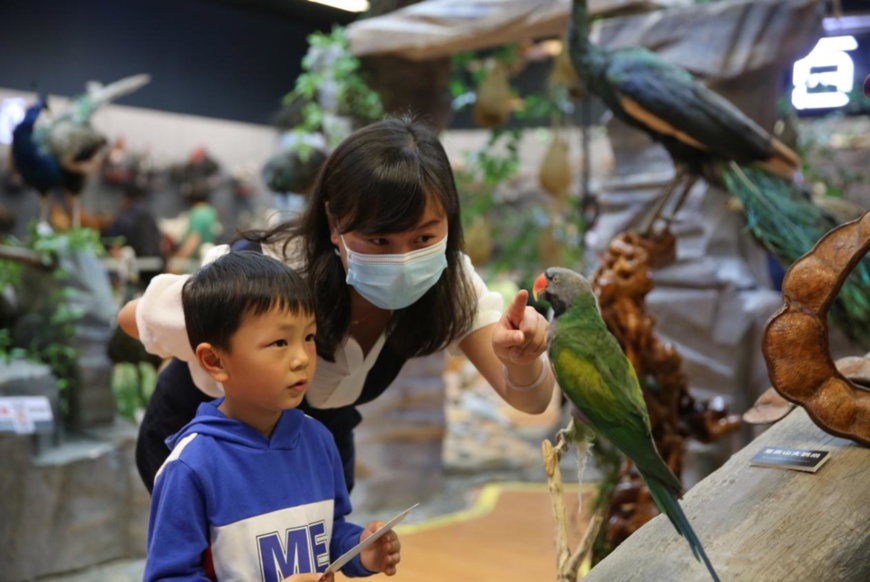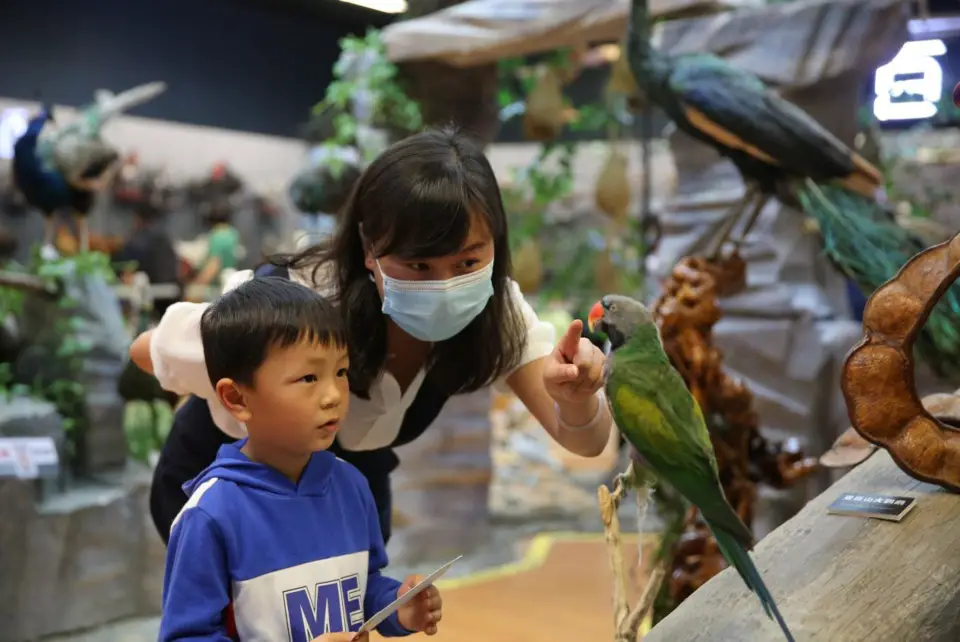By Zhang Fan, Yang Wenming, People's Daily

A boy watches a rare bird specimen at the Kunming Natural History Museum of Zoology, southwest China's Yunnan province, May 15, 2021. (Photo by Liang Zhiqiang/People's Daily Online)
Southwest China's Yunnan province has achieved significant progress in biodiversity conservation over the recent years.
It has artificially bred the first filial generation of green peafowls and the third of black snub-nosed monkeys.
The Germplasm Bank of Wild Species, the world's second-biggest and Asia's largest wildlife germplasm bank, is currently located in the province. It promulgated the new concept of plant species with extremely small populations and implemented a full-coverage native plants conservation plan. So far, the province has completed an evaluation and field investigation for nearly 2/3 of China's native plants.
Wang Lisong is a researcher with the Kunming Institute of Botany (KIB), Chinese Academy of Science. Sunburns and mosquito bites are a daily routine of his work when trekking in the wild. Spending over six months each year collecting samples in the field, he has discovered 36 new lichen species, completed over 8,200 relevant documents, and studied more than 2,000 lichen species. What he has accomplished has created the groundwork for China's largest lichen resource bank.
In 2017, the KIB, in collaboration with Chinese and foreign scientific research teams, discovered and named a new hylobatidae species - the Hoolock tianxing. According to an official document recording the new species found in Yunnan between 1992 and 2020, the province has spotted 3,718 new species during the period, including 2,519 new species and 1,199 newly recorded species.
Due to severe illnesses, including suppuration of the umbilical cord, a newborn baby elephant in Yunnan's Xishuangbanna Dai autonomous prefecture was abandoned by its herd barely six days after its birth on August 28. The Asian Elephant Breeding and Rescue Center at Xishuangbanna National Nature Reserve later rescued the cub.
Since its inception in 2008, the facility has rescued 24 wild Asian elephants. Furthermore, nine elephants were bred there, and they all survived.
Thanks to years of efforts and exploration, the population of multiple rare and endangered wild animals have been on a stable recovery, including the Asian elephant, black snub-nosed, monkey and black-crested gibbon.
The Germplasm Bank of Wild Species, established in 2007 by the KIB, had preserved 85,046 plant seeds of 10,601 species as of December the last year, which accounted for 36 percent of the number of flowering plant species in China.
The Germplasm Bank of Wild Species and the KIB, relying on their national key laboratories, systematically studied the chemical composition of 1,271 plants from 589 genera under 201 families and released information of over 10,000 natural products. A large batch of medicines made with plant extractions have been launched, and the labs have gradually grown into global research leaders in phytochemistry.
It has artificially bred the first filial generation of green peafowls and the third of black snub-nosed monkeys.
The Germplasm Bank of Wild Species, the world's second-biggest and Asia's largest wildlife germplasm bank, is currently located in the province. It promulgated the new concept of plant species with extremely small populations and implemented a full-coverage native plants conservation plan. So far, the province has completed an evaluation and field investigation for nearly 2/3 of China's native plants.
Wang Lisong is a researcher with the Kunming Institute of Botany (KIB), Chinese Academy of Science. Sunburns and mosquito bites are a daily routine of his work when trekking in the wild. Spending over six months each year collecting samples in the field, he has discovered 36 new lichen species, completed over 8,200 relevant documents, and studied more than 2,000 lichen species. What he has accomplished has created the groundwork for China's largest lichen resource bank.
In 2017, the KIB, in collaboration with Chinese and foreign scientific research teams, discovered and named a new hylobatidae species - the Hoolock tianxing. According to an official document recording the new species found in Yunnan between 1992 and 2020, the province has spotted 3,718 new species during the period, including 2,519 new species and 1,199 newly recorded species.
Due to severe illnesses, including suppuration of the umbilical cord, a newborn baby elephant in Yunnan's Xishuangbanna Dai autonomous prefecture was abandoned by its herd barely six days after its birth on August 28. The Asian Elephant Breeding and Rescue Center at Xishuangbanna National Nature Reserve later rescued the cub.
Since its inception in 2008, the facility has rescued 24 wild Asian elephants. Furthermore, nine elephants were bred there, and they all survived.
Thanks to years of efforts and exploration, the population of multiple rare and endangered wild animals have been on a stable recovery, including the Asian elephant, black snub-nosed, monkey and black-crested gibbon.
The Germplasm Bank of Wild Species, established in 2007 by the KIB, had preserved 85,046 plant seeds of 10,601 species as of December the last year, which accounted for 36 percent of the number of flowering plant species in China.
The Germplasm Bank of Wild Species and the KIB, relying on their national key laboratories, systematically studied the chemical composition of 1,271 plants from 589 genera under 201 families and released information of over 10,000 natural products. A large batch of medicines made with plant extractions have been launched, and the labs have gradually grown into global research leaders in phytochemistry.
 Menu
Menu
 Yunnan stays active in biodiversity conservation
Yunnan stays active in biodiversity conservation
















